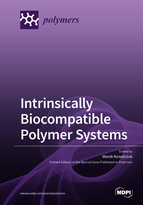Intrinsically Biocompatible Polymer Systems
A special issue of Polymers (ISSN 2073-4360). This special issue belongs to the section "Biomacromolecules, Biobased and Biodegradable Polymers".
Deadline for manuscript submissions: closed (15 October 2019) | Viewed by 94469
Special Issue Editor
2. Centre of Polymer and Carbon Materials, Polish Academy of Sciences, 41-800 Zabrze, Poland
Interests: biocompatible and biodegradable polymer systems; polymer mass spectrometry; bioactive oligomers; controlled drug delivery systems; ring-opening polymerization; forensic engineering of advanced polymeric materials
Special Issues, Collections and Topics in MDPI journals
Special Issue Information
Dear Colleagues,
The definition of biocompatibility was re-defined ten years ago, as follows: “Biocompatibility refers to the ability of a biomaterial to perform its desired function with respect to a medical therapy, without eliciting any undesirable local or systemic effects in the recipient or beneficiary of that therapy, but generating the most appropriate beneficial cellular or tissue response in that specific situation, and optimising the clinically relevant performance of that therapy”, which reflects current developments in the area of biocompatible polymers. Biocompatible polymeric materials are presently use as, e.g., long-term implantable medical devices, degradable implantable systems, transient invasive intravascular devices, and, recently, as tissue engineering scaffolds.
The biosafety of biocompatible polymers needs prediction, evaluation and indication on potential complications arising from their use and the formation of their degradation products. Thus, the methodology of forensic engineering of advanced polymeric materials is currently being developed in the area of biocompatible polymers.
This Special Issue welcomes full papers and short communications highlighting the aspects of the current trends in the area of biocompatible polymers.
Prof. Marek M. KowalczukGuest Editor
Manuscript Submission Information
Manuscripts should be submitted online at www.mdpi.com by registering and logging in to this website. Once you are registered, click here to go to the submission form. Manuscripts can be submitted until the deadline. All submissions that pass pre-check are peer-reviewed. Accepted papers will be published continuously in the journal (as soon as accepted) and will be listed together on the special issue website. Research articles, review articles as well as short communications are invited. For planned papers, a title and short abstract (about 100 words) can be sent to the Editorial Office for announcement on this website.
Submitted manuscripts should not have been published previously, nor be under consideration for publication elsewhere (except conference proceedings papers). All manuscripts are thoroughly refereed through a single-blind peer-review process. A guide for authors and other relevant information for submission of manuscripts is available on the Instructions for Authors page. Polymers is an international peer-reviewed open access semimonthly journal published by MDPI.
Please visit the Instructions for Authors page before submitting a manuscript. The Article Processing Charge (APC) for publication in this open access journal is 2700 CHF (Swiss Francs). Submitted papers should be well formatted and use good English. Authors may use MDPI's English editing service prior to publication or during author revisions.
Keywords
- Structure-property relationships of biocompatible polymers
- Characterization of biocompatible polymers
- Biodegradable polymers for medical applications
- Biosafety of biocompatible polymeric materials
- 3-D polymeric scaffolds
Related Special Issue
- Intrinsically Biocompatible Polymer Systems II in Polymers (9 articles)







